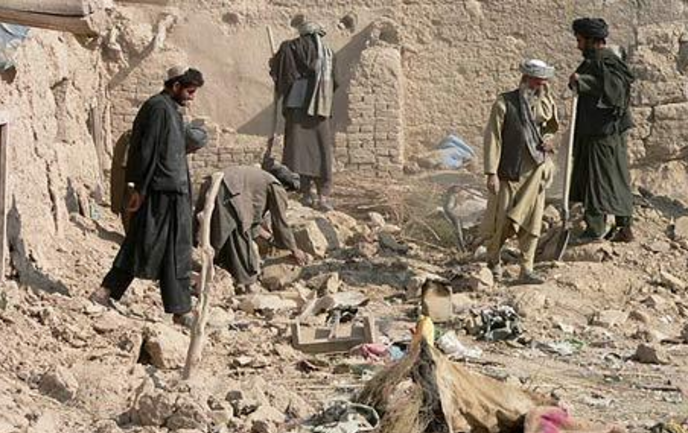Many commentators are likening the recent Taliban seizure of Kabul to a “repeat” of the 1975 “fall of Saigon”.
But the Taliban less closely resemble Vietnamese communists than they do Pol Pot’s Khmer Rouge in Cambodia. More than two decades ago, when the Taliban, a Sunni Islamist group, held power in Afghanistan, they massacred members of their country’s Shia Muslim minority and others. In the late 1970s, the Khmer Rouge had committed genocide against Cambodia’s Cham Muslim minority and others. In March 2001, the Taliban deployed dynamite to blow up their country’s monumental 6th-7th century stone sculptures, the Bamyan Buddhas, part of Afghanistan’s historic heritage. That act of vandalism resembled the Khmer Rouge’s demolition of Phnom Penh’s Catholic Cathedral, stone by stone, and their repression of Cambodia’s Buddhist religion.
Cleanup following U.S. bombing of a village wedding in 2008 (EPI photo)
Ashley Jackson writes: “Many Afghans I’ve spoken with in cities now fear the worst, recalling what life was like under Taliban rule before 2001. The urban areas arguably suffered worst, as they represented moral danger and corruption to the Taliban.” (New York Times, Aug. 17, 2021) Does the Taliban’s anti-urban thinking recall the Khmer Rouge and their forced evacuation of Phnom Penh and Cambodia’s other cities in 1975 ?
It remains to be seen whether the now reinstalled Taliban regime will launch a new campaign of Islamist fundamentalist repression. Statements from female Afghan journalists that “We see silence filled with fear” (London Guardian, Aug. 16), and reports of terror in some rural towns, are not encouraging. Nor is the news that in Bamyan province, the Taliban have blown up the statue of a Shia leader whom they killed in 1996.
Another parallel between Cambodia and Afghanistan is the way, since 2005, the Taliban recruited and rebuilt the armed following that has swept them back to power in recent weeks. The brutal prosecution of a war may damage moderate forces and help generate the ascendancy of a hardline or even genocidal insurgent group. This happened in Cambodia in the early 1970s, when the spread of the Vietnam War there facilitated the rise of the Khmer Rouge regime led by Pol Pot.
As in Cambodia, one important factor in Afghanistan has been rural revulsion against heavy United States bombing of the countryside and other excessive use of military force. The New York Times (March 27, 2010) reported that the persistence of “deadly convoy and checkpoint shootings” by U.S. forces “has led to growing resentment among Afghans fearful of Western troops and angry at what they see as the impunity with which the troops operate – a friction that has turned villages firmly against the occupation.” Gen. Stanley McChrystal, then the senior U.S. and NATO commander in Afghanistan, said in 2010: “We have shot an amazing number of people, but to my knowledge, none has ever proven to be a threat.” Even so, the casualties from such shootings were “fewer in number than deaths from air strikes and Special Forces operations.”
Many Afghans who had known the victims of these shootings, air strikes, and operations eventually did become a threat. They joined the Taliban army, which is now victorious.
That specific U.S. military operations contributed to rather than prevented the resurgence of the Taliban is tragic, as well as ironic. The initial U.S. involvement in Afghanistan, after the September 11 attacks and the Taliban’s sheltering of Al Qaeda, had the justification of self-defense, unlike the subsequent, illegal U.S. invasion of Iraq. But just as the Iraq war saw the rise of the genocidal ISIS group in Iraq and Syria, the prolonged conflict in Afghanistan and in particular the U.S. resort to bombardment of rural areas there helped fuel the return of the Taliban as a formidable force. The Afghanistan war might have been conducted very differently, especially in the light of what had earlier happened in Cambodia.
Taylor Owen and I analyzed these issues in “Roots of U.S. Troubles in Afghanistan: Civilian Bombing Casualties and the Cambodian Precedent,” published in The Asia Pacific Journal (8:26, no. 5) on June 28, 2010.






